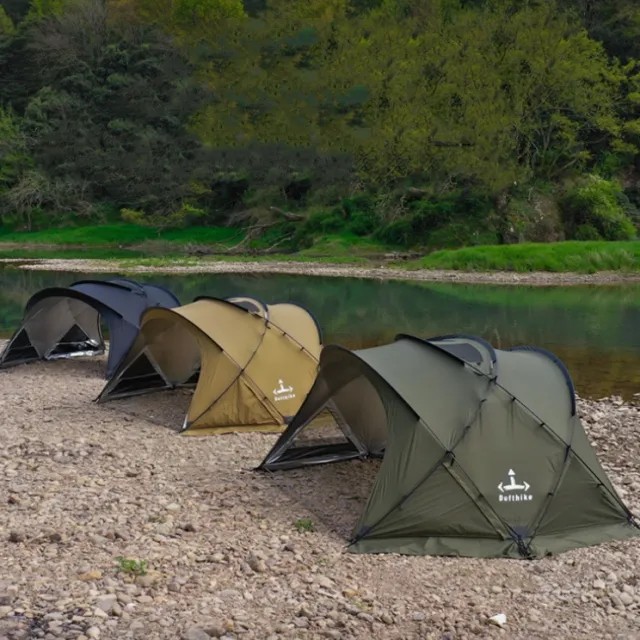How to make a camping tent more stable?
A stable camping tent is crucial for a successful and enjoyable camping experience. As a camping tent supplier, I understand the importance of ensuring that tents can withstand various environmental conditions. In this blog, I will share some effective ways to make a camping tent more stable.
Choose the Right Tent Design
The design of the tent plays a significant role in its stability. Different types of tents have different structural characteristics. For example, dome - shaped tents are generally more stable in windy conditions compared to ridge - shaped tents. The curved shape of dome tents helps to deflect wind, reducing the pressure on the tent structure.
However, ridge tents, like our Ridge Camping Tent, also have their own advantages. They usually offer more headroom and a simple, straightforward design. If you choose a ridge tent, make sure it has proper support poles and a well - designed frame to enhance its stability.
For family camping, our Camping Tent For Family is a great option. These tents are often larger and need to be more stable to accommodate more people and their belongings. They are designed with reinforced frames and multiple support points to ensure stability.
Select a Suitable Campsite
The location where you set up your tent can greatly affect its stability. First, look for a flat and level surface. Uneven ground can cause the tent to tilt, putting extra stress on the poles and guy lines. Use a ground cloth or a tarp to create a smooth base for the tent.
Avoid setting up your tent in low - lying areas where water may accumulate during rain. Water can seep into the tent and make the ground soft, reducing the stability of the tent. Also, stay away from areas with overhanging branches or other potential hazards that could fall on the tent during a storm.
If possible, choose a campsite that is sheltered from strong winds. Natural barriers such as hills, trees, or large rocks can provide some protection. However, make sure the trees are healthy and not at risk of falling.
Properly Stake the Tent
Staking the tent is one of the most important steps in ensuring its stability. Use high - quality stakes that are appropriate for the type of ground you are camping on. For soft soil, long and thin stakes work well, while for hard or rocky ground, you may need shorter and thicker stakes or even rock pegs.
Insert the stakes at a 45 - degree angle away from the tent. This helps to pull the tent down and keep it firmly in place. Make sure the stakes are driven deep enough into the ground so that they won't easily come out. Check all the stakes regularly, especially after strong winds or heavy rain, to ensure they are still secure.
In addition to the corner stakes, use the additional stake points provided on the tent. These extra stakes can help to distribute the tension evenly across the tent and prevent it from sagging or shifting.
Use Guy Lines
Guy lines are ropes that are attached to the tent and staked into the ground to provide additional support. They help to keep the tent upright and prevent it from being blown over by strong winds. Most tents come with pre - attached guy lines, but you can also add more if needed.
Attach the guy lines to the designated points on the tent, usually at the corners and along the sides. Make sure the guy lines are taut but not too tight, as this could damage the tent fabric. Stake the guy lines into the ground at a 45 - degree angle, similar to the tent stakes.
When using guy lines, consider the direction of the wind. Adjust the tension of the guy lines on the windward side to counteract the force of the wind. You can also use tensioners or knots to easily adjust the tightness of the guy lines.
Reinforce the Tent Poles
The tent poles are the backbone of the tent, and reinforcing them can significantly improve its stability. Some tents come with additional pole sleeves or straps that can be used to strengthen the poles. You can also use pole repair kits to fix any minor damages to the poles.
If you are camping in extremely windy or harsh conditions, you may want to consider using additional poles or support structures. For example, you can use a center pole in a large tent to provide extra support in the middle. This can help to prevent the tent from collapsing under the weight of snow or strong winds.
Check and Maintain the Tent Regularly
Regular maintenance is essential for keeping your tent stable. Before each camping trip, inspect the tent for any signs of damage, such as tears in the fabric, broken poles, or loose guy lines. Repair any damages as soon as possible to prevent them from getting worse.
After each use, clean the tent thoroughly and let it dry completely before storing it. This helps to prevent mold and mildew growth, which can weaken the tent fabric over time. Store the tent in a cool, dry place to keep it in good condition.
Upgrade Your Tent Accessories
There are many accessories available that can enhance the stability of your tent. For example, you can use heavy - duty guy line tensioners to keep the guy lines tight. These tensioners are easy to use and can provide a more secure hold.
Another useful accessory is a tent footprint. A footprint is a protective layer that goes under the tent, providing an extra barrier between the tent and the ground. It can also help to keep the tent floor clean and dry, and in some cases, it can add a little extra stability by providing a more even surface.
Consider the Weather Conditions
Before you go camping, check the weather forecast. If strong winds or storms are expected, take extra precautions to make your tent more stable. You may need to reinforce the guy lines, add more stakes, or even consider moving to a more sheltered campsite.
In snowy conditions, make sure to clear the snow off the tent regularly. The weight of the snow can put a lot of stress on the tent poles and cause the tent to collapse. Use a soft brush or a broom to gently remove the snow without damaging the tent fabric.
In conclusion, making a camping tent more stable requires a combination of proper tent selection, a suitable campsite, correct setup techniques, and regular maintenance. By following these tips, you can ensure that your tent can withstand various environmental conditions and provide a safe and comfortable shelter during your camping trips.


If you are interested in purchasing high - quality camping tents or need more information about tent stability, please feel free to contact us for procurement and negotiation. We are committed to providing you with the best camping tent solutions.
References
- Coleman Outdoor Products Guide. Coleman.
- REI Co - op Camping Handbook. REI.
- Outdoor Gear Lab Tent Reviews. Outdoor Gear Lab.
